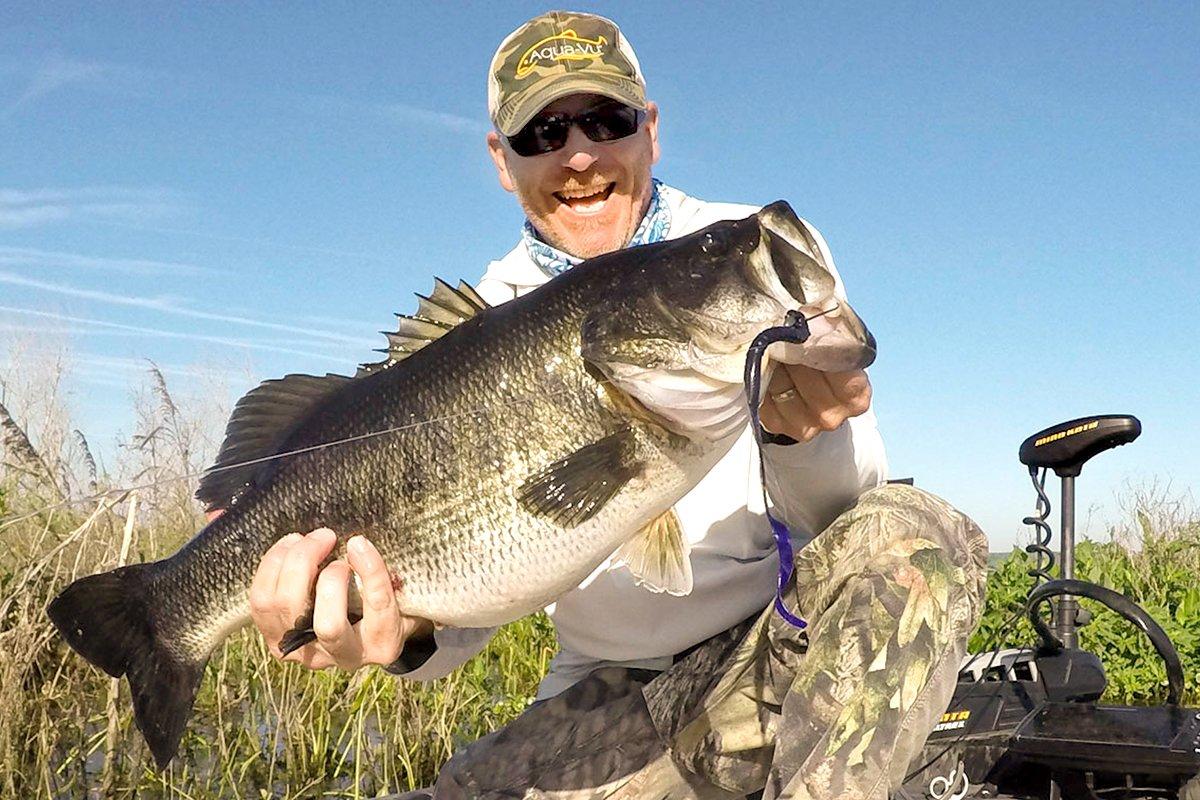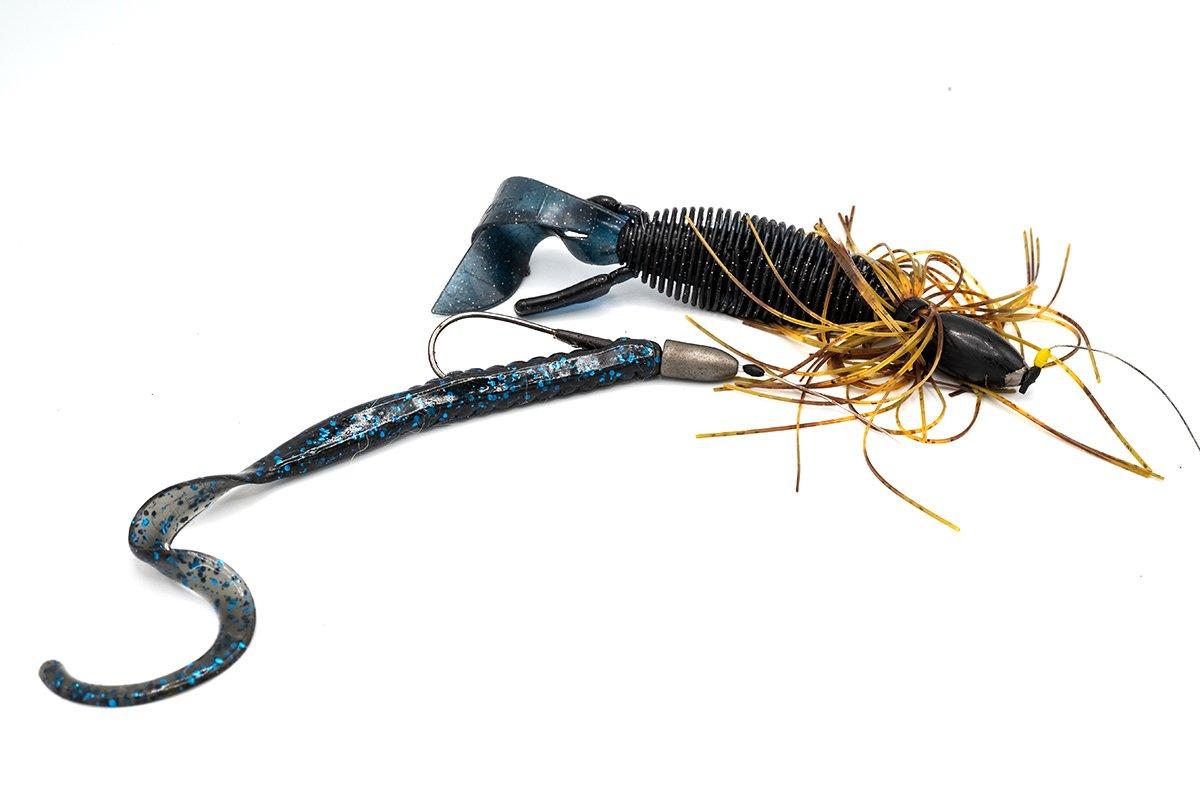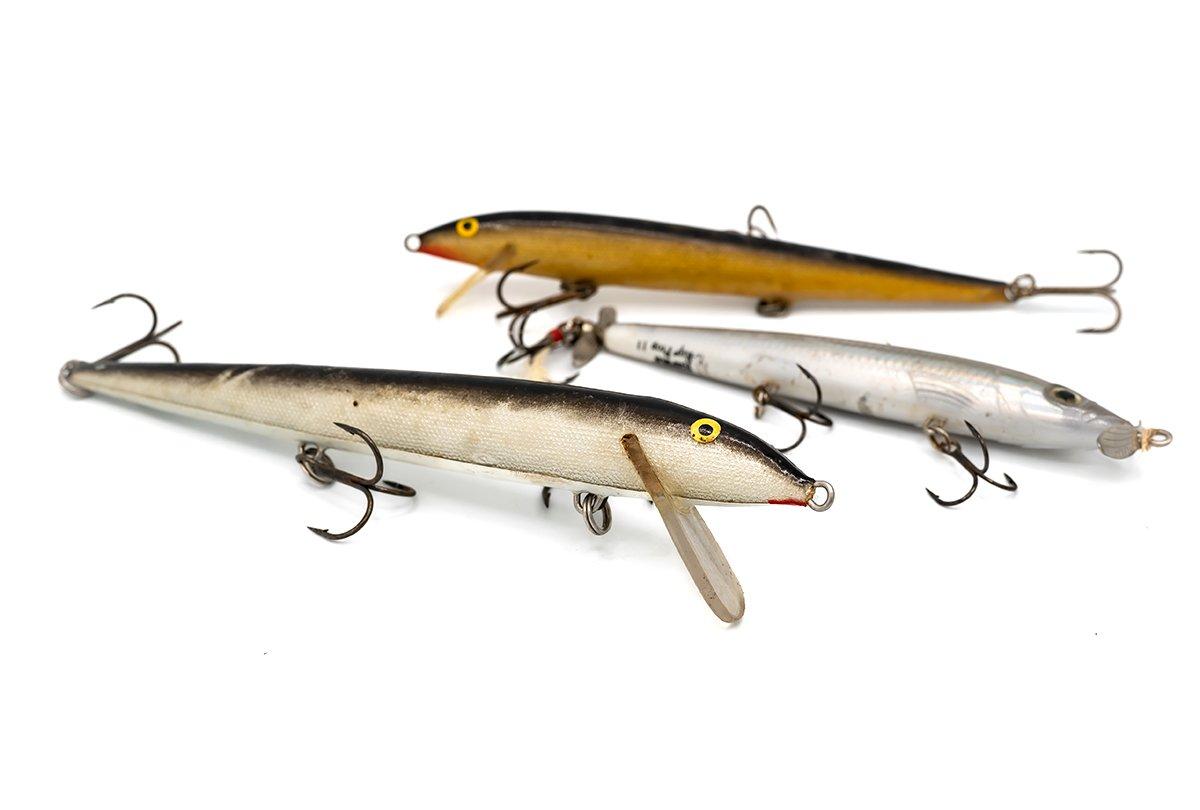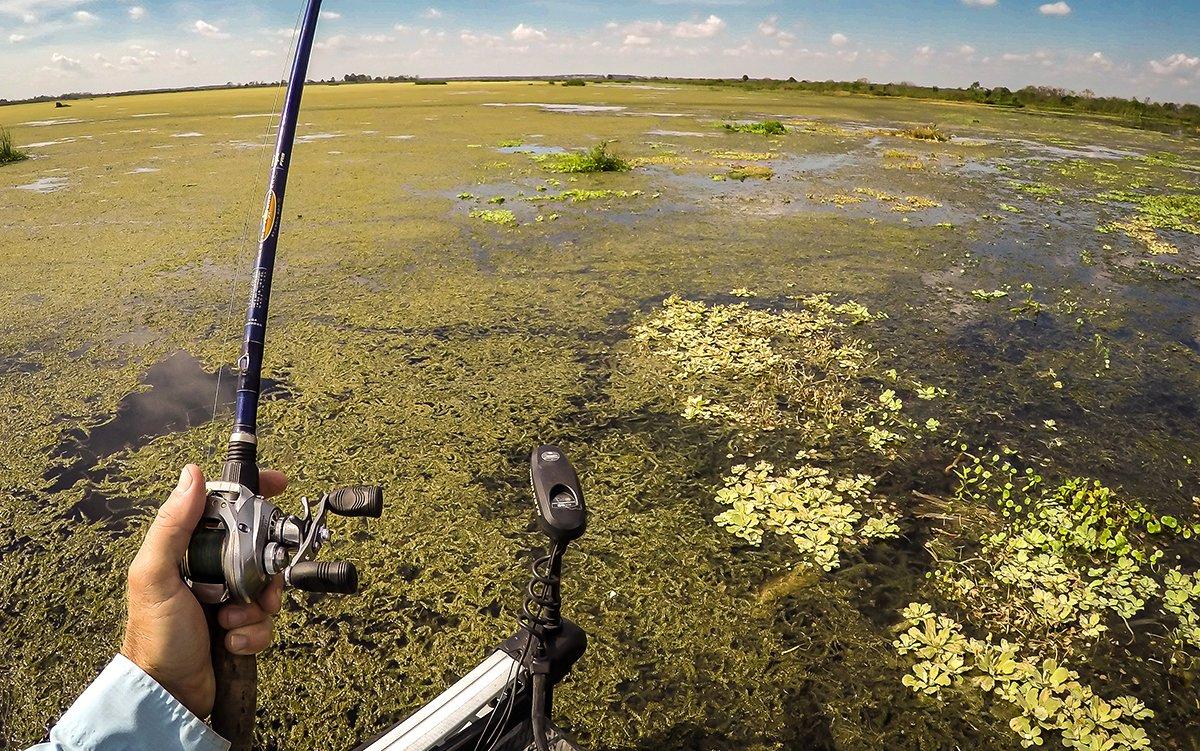A fishing trip to the Sunshine State might be the best way of all to spend the holidays. Here's where to go and how to catch them
If you're a bass fishing junkie like me, it may be time for a trip to a winter paradise, filled with pot-bellied bigmouths eager to eat a buzzbait. But where to go?
For generations, anglers have headed to the Sunshine State to scratch an itch left by the cold and dreary North. I was once such a fisherman myself. Born to dismal lives in the Midwest, my father and I would escape each year for a pilgrimage to Florida, the Holy Land of bass fishing, where 10-pounders, it was said, hid behind every flooded willow bush.
True, fishing was never that easy. But I did catch a double-digit largemouth by the time I was 12. That fish, as well as the experiences only Florida bass fishing can create, likely impacted my decision to move south some 30 years later. My commute to some of Florida's best fisheries now rarely exceeds an hour.
You want to get in on it. Deer season's over and ice fishing is, well, ice fishing. Florida can save the day. I'm going to give you a breakdown of everything you need to know for a great vacation; a tear-sheet of sorts to cut the learning curve.
(Don't Miss: Advanced Tips for Bass Fishing Boat Docks)
It's a Big Place
First thing's first. If you've ever driven to South Florida for a fishing trip, you've undoubtedly been through the routine. After passing beneath the Florida welcome sign, you breath a sigh of relief, happy to have made it to your destination. Eight hours later, you've been bamboozled! How can one state be this big?
True, Florida is a vast landmass. You'll need to dial in your travel to avoid more time in the truck than the boat. Chances are, you'll be coming for reasons outside of just bass fishing. Beaches, theme parks, golf; these things all factor in, especially when traveling with the family. Fear not, good bass fishing isn't far from your condo. Here's my pick of the state's best, per region, for an outlandish bass:
North Florida / Florida Panhandle
Lake Seminole instantly takes you into a lost world. Wingate's Lunker Lodge is reason enough to travel to this original bass fishing destination, circa 1968. Original owner Jack Wingate appeared on the cover of Bassmaster Magazine's second issue, to give you some idea of history.
Lake Talquin, near Tallahassee, is always good. And, if you can gain access through a military exemption, be sure to check out Kingsley Lake near Camp Blanding, home to more giant bass catches than anywhere in Florida over the past five years. This area is a bit cold around Christmas, so look for winter patterns involving deep-ish water or ultra-heavy cover.
Central Florida
Rodman Reservoir is Florida's overall best big-bass fishery since its creation in the late-60s. Today, it remains remote and cover-filled, as bass lakes should be. Orange and Lochloosa lakes have peaks and valleys coinciding with water levels. Currently, they're peaking. The Harris Chain — all those lakes around The Villages — are always good, and they're maintained nowadays to promote healthy fisheries. Here, December brings the beginning of pre-spawn feeding. And don't waste your time on the St. John's River system, as recent floods have again decimated the bass fishery.
Central / South Florida
The Fellsmere complex gets all the press these days, with Headwaters Lake being the best in the state for numbers, with lots of 7-pounders tossed in. Stick Marsh still cranks out some giants, but is hampered on windy days, so take note. Lake Garcia flies under the radar for most, but offers a true sample of South Florida bass fishing in a smaller, more comfortable package. Think Okeechobee, without getting lost.
South Florida
Lake Kissimmee begins to heat up this time of year, as big fish go on the prowl and prepare for a February spawn. Here, most of the lake remains the way it's been for decades, and shallow vegetation dominates.
Lake Istokpoga was once a big-bass player, but habitat problems persist. Instead, jump over to Lake Placid and June In Winter if you're in the area. Waters are crystal clear, but hold some lunkers. Never leave out Okeechobee. Here, again, habitat problems persist, reducing the amount of fishy water, but there are still thousands of acres. Fish begin a spawn in December, making for the possibility of fishing shallow targets through a four-month stretch.
Once you've settled on a spot, it's time to spool up the reels. Tackle prep for your Florida destination should be easy. Here's where I can really help out.
(Don't Miss: The 3 Best Lures for Catching a 10-Pound Bass)
The Arsenal
For nearly a decade now, I've continued to reduce my tackle supply. Delighted buddies up North and savvy eBay shoppers have been the recipients of my purge. The longer I live and bass fish in Florida, the more I realize how so few lures are necessary to come out ahead. Day in and day out, for particularly large bass, I've come to rely most on the following:
Plastic Worms
Start with the best. More giant Florida bass are caught on soft plastics than every other lure combined. It's always been that way. Texas-rigged plastics are the most efficient baits for fishing Florida's heavy cover. On lakes with thick, dense overhead mats, punch rigs excel. Stick to compact, Beaver-style baits. Where cast and retrieving is better through submerged grasses and vast reed banks, go old-school with a 7-inch Culprit. Always have a Senko tied on, too, especially around the spawn, and don't be underwhelmed by a straight-tail, trick worm-type bait on a light sinker. Florida bass, overall, don't fall for lots of frills; keep it simple.
I once carried dozens of colors of worms and craws. Now I carry Junebug, red shad, and black. Period.
Plastic Swimmers
Ever hear of a Skinny Dipper? One of the first of its kind, this lure brought a reliable swimbait action to shallow vegetation, perfect for Florida's calm waters. Other brands followed suit. The Big E-Z is a big player. When winds are calm and the water's clear, try buzzing an Ultravibe Speedworm. For heart-stopping strikes around vast areas of hydrilla, frogs and toads excel. Florida bass are suckers for topwater gurgling and buzzing with subtle plastic tails. Occasionally a buzzbait works, but it's often too obnoxious for pressured fish.
Spinnerbaits
Every other bass fishing aficionado will sell you on a Chatterbait, but a spinnerbait still reigns supreme for me. It's true, lots of cast-and-retrieve lures will catch big bass all across the country. Square-billed cranks and bladed jigs are no exception. But the spinnerbait excels in Florida due to its relative silence and natural look. Big, gold willow blades are at home here. Pick up a spinnerbait in the afternoon once the wind is howling, and be ready.
The Original, Floating Rapala
Often imitated and still never matched, after 60 years. I use the biggest one available — the F11 model — and catch more big bass on it than any other hardbait, year after year. Fish this buoyant bait more as a topwater than a jerk bait, and match it with 20-pound monofilament for best action. Cast and wait. Twitch. Repeat. Be sure to replace weakened stock hooks with more powerful models. We're after BIG bass here, son.
Topwater Prop Bait
Old-school anglers call these Devil's Horses, as that model was a traditional player. More modern brands cast better. All work well, especially around the spawn. Again, the key is to fish slow, much like the big Rapala. When a 10-pounder boils beneath your lure, you'll actually feel your heart stop.
So that's going to complete our tackle box. In Florida, it's always much better to find productive areas than nit-pick the details. With hundreds of vast fisheries, many of which look bassy from shore-to-shore, fishing is often a needle in a haystack affair.
(Don't Miss: 5 Favorite Fall Fishing Bites)
Finding Fish
Like anywhere, the key is to eliminate unproductive water. For starters, Florida fish have evolved to relate to the wind. Much the way big-water bass bite when seas are rough, Florida bass rely on wind-driven currents to increase their activity and bring food to them. Always key on areas exposed to main-lake currents. While you need not ride out 4-footers on the windy side of Okeechobee, it's a good idea to concentrate on spots with a moderate chop over those on a slick-calm bank.
Cattails, maidencane, and reed clumps with lanes cutting through are prime big bass spots. Neck-down areas of lakes hold more fish. Creek mouths. The windy sides of islands. Channels and canals connecting waterways. All of these bring food by the bass and get better when the wind blows, which it does, most warm afternoons.
Eliminate the most remote backwater areas unless a lake has flow. Most of the places, though great looking, simply don't hold large concentrations of big bass. Feeding opportunities are better in the main sections of a lake or reservoir.
And never, ever overlook any piece of horizontal, overhead cover. Hyacinth and pennywort mats, matted hydrilla, tussocks, lily pad root wads, mud mats, docks; whatever offers a roof to a big bass is a place you need to get a bait. Without question, more big bass are caught under things in Florida than anywhere else. Don't go under-gunned. I still flip these places with a discontinued, 9-foot St Croix Rod I helped design just to get lunkers out of the thickest spots.
Here are a few more hard, fast rules to get you more bites from Florida giants this winter:
- Fishing thick submerged grass, like hydrilla, is always best in the afternoon. Most anglers leave the lake before it gets good.
- Fluorocarbon and monofilament lines get far more bites than straight braid. Only use braid when you absolutely have to.
- Most 10-pounders weigh about 8 pounds. After years of relentless pursuit of trophy bass, my records indicate I'll catch, on average, 10 fish weighing 8 to 10 pounds apiece for every one exceeding that mark. Ten-pound bass are extremely rare, even in Florida.
- Never fish by a shiner fisherman, regardless of the bait you're using. Once big bass dial in on a boat feeding them shiners (frequently, many shiners are lost while fishing), they rarely stray for anything else. Move on, before you pull your hair out.
- Don't buy into magic lure syndrome. Stick to what I've preached, and refrain from purchasing baits the tackle stores insist that you must. While it's nice to support the local economy, spend your dollars on gas and beef jerky. Each will result in a more reliable outcome than a bag of magic worms.
Bass fishing in the Sunshine State is simply unlike anywhere else. Even with 22 million people now living in the nation's third-largest state, there are still opportunities to feel like you're at the end of the earth. Exotic birds scream, alligators bellow and the sawgrass sways. Where else would you rather be?
(Don't Miss: Shallow-Water Fall Bass Tactics)














